

Yellowstone National Park Wolf Information
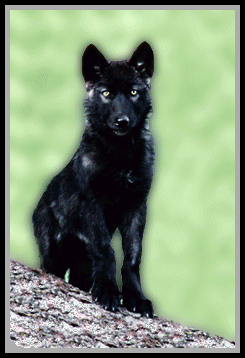
There are three (3) canids that inhabit Yellowstone National Park, the red fox (Vulpes vulpes), the coyote (Canis latrans), and the gray wolf (Canis lupus). “The gray wolf was purposefully shot, trapped, or poisoned in Yellowstone National Park from its establishment in 1872 until 1933, when the National Park Service ended its predator control efforts. By the mid-1930s, however, the last wolf pack was gone from Yellowstone” (Yellowstone Wolf Project Report 1995/1996). Studies started in 1972 through 1994 on restoring wolves to Yellowstone. In March of 1995 gray wolves were reintroduced thus bringing all natural wildlife back to the ecosystem.
2017 Wolf Report
There were at least 97 wolves in 11 packs (3 breeding pairs) living primarily in Yellowstone National Park (YNP) at the end of December 2017 (figures 1 & 2; table 1). Overall, wolf numbers have fluctuated little from 2009 to 2017 (83-108 wolves) while breeding pairs (defined as an adult male and an adult female with two pups that survive through the end of the year) have typically been two to three times higher than the 2017 count. Pack size in 2017 ranged from 2 to 21, averaging 8.8 in size. Park-wide, 21 pups survived to year end, only 5 in northern Yellowstone and 16 in the interior of the park. Five packs had total litter loss and over half of the park’s recorded pups were in the Wapiti Lake pack.
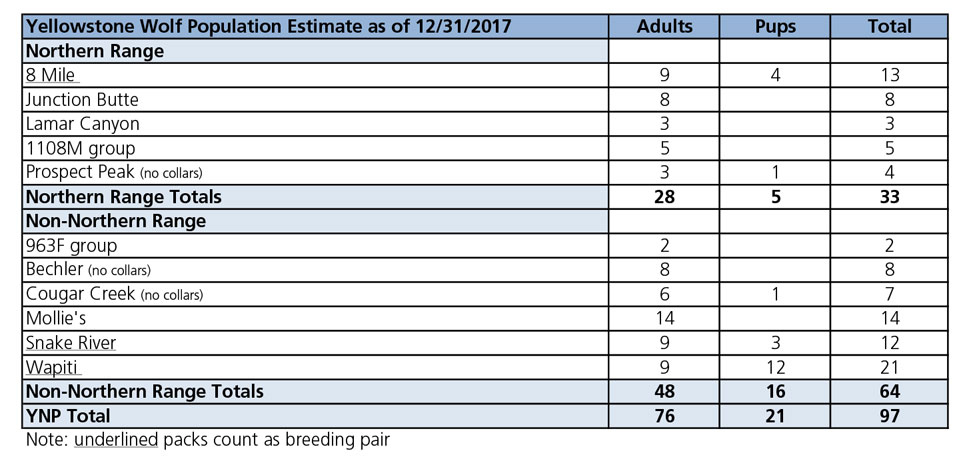
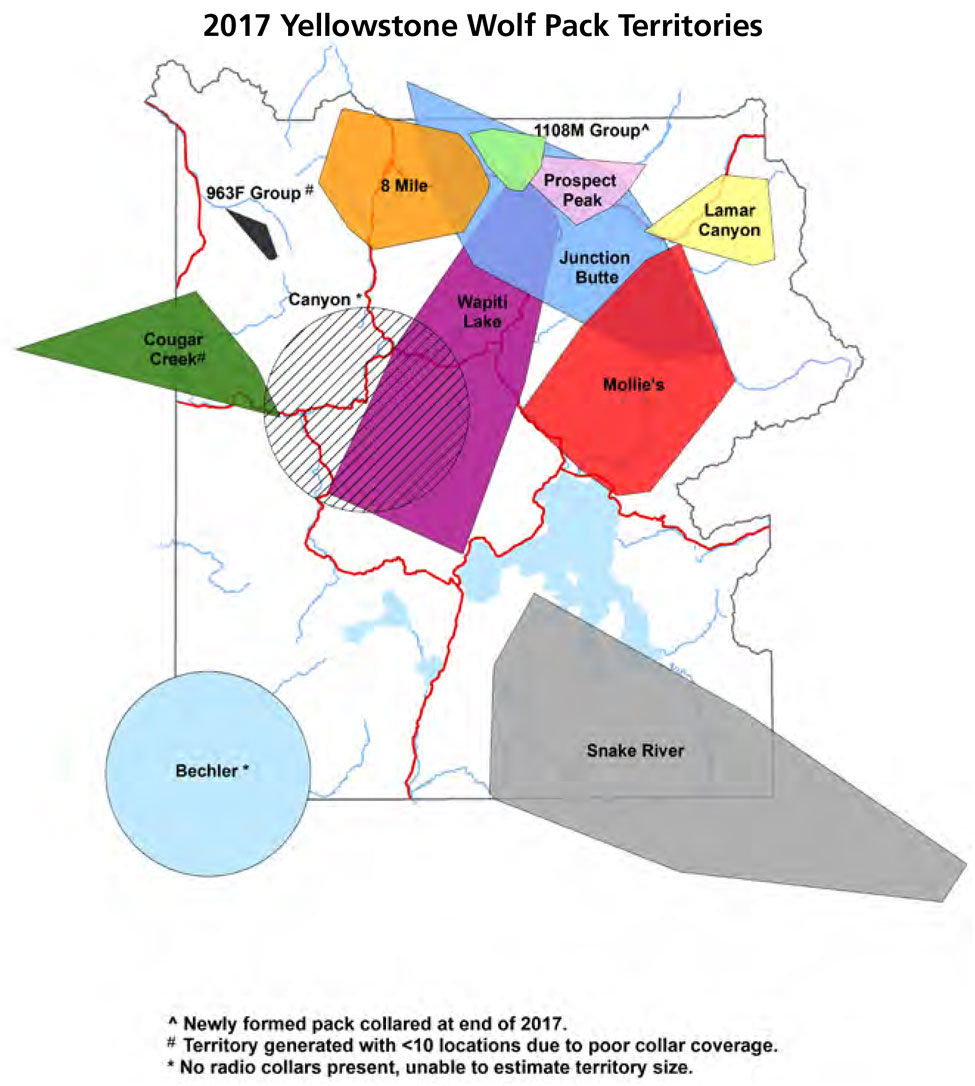
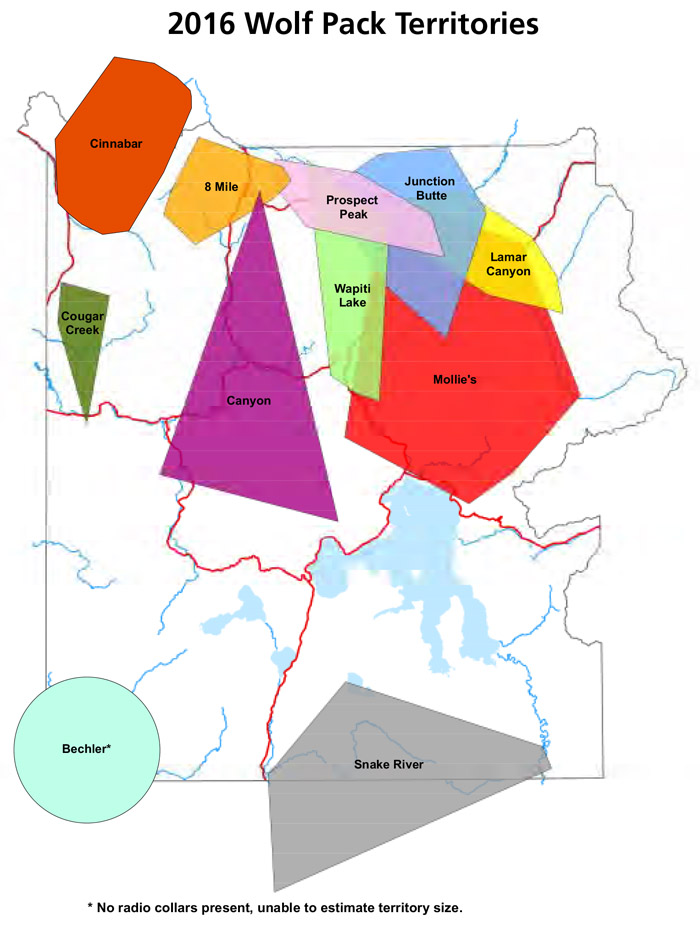
2016 Summary
There were at least 108 wolves in 11 packs (7 breeding pairs) living primarily in Yellowstone National Park (YNP) through December 2016 (figures 1& 2). Breeding pairs are defined as an adult male and an adult female with two pups that survive through the end of the year. Overall, wolf numbers have fluctuated between 83-108 wolves and 6-9 breeding pairs from 2009 to 2016. Pack size in 2016 ranged from 3 to 18 (table 1), averaging 9.8 in size. Park-wide, 36 pups survived to year end, 16 in northern Yellowstone and 20 in the interior of the park, with an average of 4.0 pups per pack surviving for 9 packs with confirmed reproduction.
| Yellowstone Wolf Pack Data as of 2016 | |||
|---|---|---|---|
| Pack | Adults | End of Year Pup Count | Total |
| 8 Mile | 8 | 10 | 18 |
| Junction Butte | 3 | 4 | 7 |
| Lamar Canyon (formerly 755 group) | 5 | - | 5 |
| Prospect Peak | 9 | 2 | 11 |
| Northern Range Totals | 25 | 16 | 41 |
| Non-Northern Range | |||
| Pack | Adults | End of Year Pup Count | Total |
| Bechler | 5 | 4 | 9 |
| Canyon | 5 | 1 | 6 |
| Cinnabar | 3 | - | 3 |
| Cougar Creek | 6 | 2 | 8 |
| Mollie's | 14 | 4 | 18 |
| Snake River | 9 | 5 | 14 |
| Wapiti Lake | 5 | 4 | 9 |
| Non-Northern Range Totals | 47 | 20 | 67 |
| Totals | 72 | 36 | 108 |
For more detailed information, please click on the Year Link at the bottom of this page.
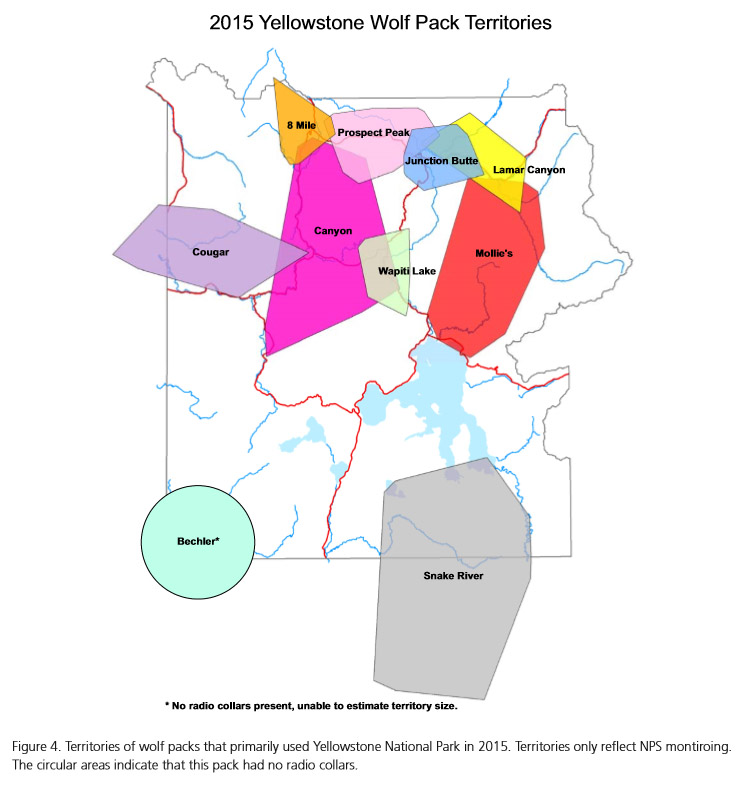
2015 Summary
There were at least 98 wolves in 10 packs (8 breeding pairs) living primarily in Yellowstone National Park (YNP) through December 2015 (figure 1). Overall, wolf numbers have fluctuated between 83-104 wolves and 6-9 breeding pairs from 2009 to 2015. Pack size in 2015 ranged from 6 to 16 (table 1) and averaged 9.7. Park-wide, 35 pups survived to year end, 21 in northern Yellowstone and 14 in the interior of the park, with an average of 4.4 per pack surviving for 8 of 10 packs with confirmed reproduction.
| Yellowstone Wolf Pack Data as of 2015 | |||
|---|---|---|---|
| Pack | Adults | End of Year Pup Count | Total |
| 8 Mile | 8 | 5 | 13 |
| Junction Butte | 6 | 8 | 14 |
| Lamar Canyon (formerly 755 group) | 6 | 3 | 9 |
| Prospect Peak | 8 | 5 | 13 |
| Lone Wolves and Ephemeral Groups (965M) | 1 | - | 1 |
| Northern Range Totals | 29 | 21 | 50 |
| Non-Northern Range | |||
| Pack | Adults | End of Year Pup Count | Total |
| Bechler | 6 | - | 6 |
| Canyon | 4 | 2 | 6 |
| Cougar Creek | 5 | 2 | 7 |
| Mollie's | 10 | 6 | 16 |
| Snake River | 7 | - | 7 |
| Wapiti Lake | 2 | 4 | 6 |
| Non-Northern Range Totals | 34 | 14 | 48 |
| Totals | 63 | 35 | 98 |
For more detailed information, please click on the Year Link at the bottom of this page.
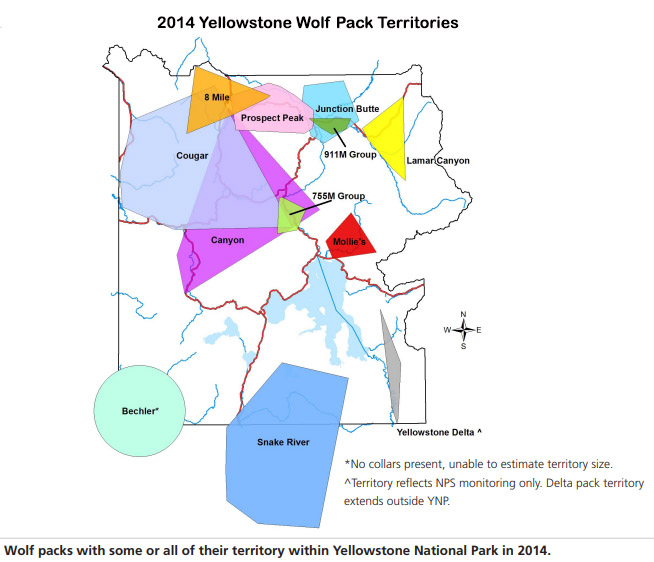
2014 Executive Summary
There were at least 104 wolves in 11 packs (figure 1), including nine breeding pairs, living primarily in Yellowstone National Park during December 2014. From 2009 to 2014, wolf numbers have fluctuated between 83 and 104 wolves, and 6 to 9 breeding pairs. Pack size in 2014 averaged 9 wolves (range = 2 to 14). Forty pups survived to year-end, including 17 in northern Yellowstone and 23 in the interior of the park. An average of 4.4 pups per pack (82%) survived in the nine packs that had pups (figure 2). For the first time, the size of a wolf pack was estimated via genetic sampling methodology, using scat samples from a den site.
| Yellowstone Wolf Pack Data as of 2014 | |||
|---|---|---|---|
| Pack | Adults | End of Year Pup Count | Total |
| 755M / 889F Group | 3 | - | 3 |
| 911 Group | 2 | - | 2 |
| 8 Mile | 7 | 2 | 9 |
| Blacktail | 1 | - | 1 |
| Lamar Canyon (formerly 755 group) | 2 | 6 | 8 |
| Junction Butte | 5 | 3 | 8 |
| Prospect Peak | 8 | 6 | 14 |
| Northern Range Totals | 28 | 17 | 45 |
| Non-Northern Range | |||
| Pack | Adults | End of Year Pup Count | Total |
| Bechler | 6 | 4 | 10 |
| Canyon | 3 | - | 3 |
| Cougar Creek | 8 | 3 | 11 |
| Mollie's | 6 | 6 | 12 |
| Snake River | 9 | 5 | 14 |
| Yellowstone Delta | 5 | 5 | 10 |
| Non-Northern Range Totals | 37 | 23 | 60 |
| Totals | 57 | 34 | 91 |
For more detailed information, please click on the Year Link at the bottom of this page.
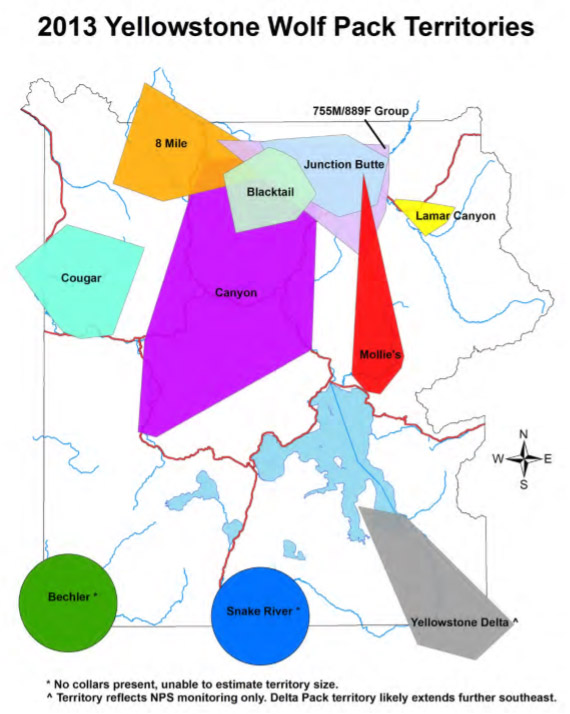
2013 Executive Summary
There were at least 95 wolves in 10 packs and one group (8 breeding pairs) living primarily in Yellowstone National Park during December 2013. These totals are slightly higher than reported in 2012, but similar to previous years when about 100 wolves were counted. Wolf numbers have decreased by about 45% since 2003 when the population estimate was 172. This is likely due to fewer elk in the ecosystem. Wolf numbers decreased less in the interior of the park than in northern Yellowstone, likely due to supplemental feeding on bison by those packs.
State-managed wolf hunts during 2013 did not significantly affect wolves primarily living in the park and the occurrence of mange continued to decrease in 2013. There was no evidence of distemper being a mortality factor as compared with previous years. Pack size ranged from 2 to 18 and averaged 8.6 wolves. Nine of 10 packs, plus one lone female, had pups. The average number of pups was 4.6, which is higher than the previous two years. At least 41 pups survived to the end of the year.
Project staff detected 269 kills that were definitely, probably, or possibly made by wolves during 2013, including 193 elk (72%), 16 bison (6%), 13 mule deer (5%), and low occurrences of other or unidentified species. The composition of elk kills was dominated by calves and yearlings (43%), followed by cows (33%) and bulls (14%). Some kills could not be identified to age or sex. Bison kills included nine calves, two yearlings, two cows, two bulls, and one adult of unknown sex. Other research involving wolves during 2013 included population genetics, population regulation, disease, hunting behavior, spatial analyses of territory use, pack leadership, multi-carnivore-scavenger interactions, breeding behavior, dispersal, and observations of wolf, grizzly bear, and bison interactions in Pelican Valley. Nine wolves in four packs were fitted with radio collars during February and early March. Seven wolves in three packs were radio-collared during December. At year’s end, 24% (21 wolves) of the wolf population was collared.
Wolf management activities included den site closures and several hazing events. Staff continued to manage wolf viewing areas in Slough Creek, the Lamar Valley, and other hot spots where wolves were frequently sighted. Public outreach included giving 265 formal talks, participating in 82 interviews, helping 18,000 people view wolves, making 18,822 visitor contacts, and giving hundreds of informal talks in the field.
| Yellowstone Wolf Pack Data as of 2013 | |||
|---|---|---|---|
| Pack | Adults | End of Year Pup Count | Total |
| 755M / 889F Group | 2 | - | 2 |
| 8 Mile | 9 | 9 | 18 |
| Blacktail | 3 | - | 3 |
| Lamar Canyon (formerly 755 group) | 2 | 2* | 2 |
| Junction Butte | 5 | 4* | 9 |
| Northern Range Totals | 21 | 13 | 34 |
| Non-Northern Range | |||
| Pack | Adults | End of Year Pup Count | Total |
| Bechler | 7 | 4 | 11 |
| Canyon | 5 | 3 | 8 |
| Cougar Creek | 7 | 6 | 13 |
| Mollie's | 2 | 5 | 7 |
| Snake River | 5 | 4 | 9 |
| Yellowstone Delta | 7 | 6 | 13 |
| Non-Northern Range Totals | 33 | 28 | 61 |
| Totals | 54 | 41 | 95 |
Data as of December 31st, 2013 furnished by the NPS
* Pups did not survive.
For more detailed information, please click on the Year Link at the bottom of this page.
2012 Executive Summary
At the end of 2012, at least 83 wolves in 10 packs (6 breeding pairs) occupied YNP. This is approximately a 15% decline from the previous three years when wolf numbers had stabilized around 100 wolves. Breeding pairs declined 25% from eight the previous year to six in 2012. Wolf numbers have declined by about 50% since 2007 mostly because of a smaller elk population, the main food of wolves in YNP. The number of wolves living in the park interior has declined less, probably because they supplement their diet with bison. State-managed wolf hunts harvested 12 wolves that lived primarily in YNP when these animals moved into Montana, Idaho, and Wyoming. The severity of mange, a skin disease caused by non-native mites, continued to decline in 2012, although some packs still showed signs of the mite. There was no evidence of distemper being a mortality factor as it was in 1999, 2005, and 2008. Pack size ranged from 4 (Blacktail and Snake River) to 11 (Lamar Canyon, Cougar, and Yellowstone Delta) and averaged 10 which is the long-term average. Seven of 11 (64%) packs had pups. The average number of pups per pack in early winter (for packs that had pups) was 2.5, which is lower than previous years’ averages of 4.1 (2011) and 4.8 (2010). A total of 20 pups in YNP survived to the end of the year (14 fewer than in 2011).
Project staff detected 255 kills (definite, probable, and possible combined) made by wolves in 2012, including 159 elk (62%), 32 bison (13%), 13 mule deer (5%), 2 whitetail deer (1%), 5 deer unknown species (2%), 4 pronghorn (2%), 2 moose (1%), 2 Canada geese (1%), 9 wolves (4%), 1 bighorn sheep (less than 1%), 1 otter (less than 1%), 1 grizzly bear cub (less than 1%), 1 coyote (less than 1%), and 23 unknown prey (9%). The composition of elk kills was 40% cows, 28% calves, 21% bulls, 4% yearlings, 4% adults of unknown sex, and 3% of unknown sex and age. Bison kills, which were recorded as the highest proportion of total kills since monitoring has been occurring, included 17 calves, 8 cows, 1 yearling, 1 bull, 2 adults of unknown sex, and 3 of unknown sex and age.
Other research included genetics, disease, hunting behavior, spatial analyses of territory use, wolf pack leadership, multi-carnivore-scavenger interactions, breeding behavior, dispersal, and observations of wolf, grizzly bear, and bison interactions in Pelican Valley. During 2012, 19 wolves were captured and collared in 9 packs. At year’s end, 21% of the wolves living in YNP were collared. Other wolf-management activities included den site closures and several hazing events. Staff continued to manage wolf viewing areas in Slough Creek and Lamar Valley and other spots where wolves were frequently sighted, leading to a minimum estimate of 27,500 people observing wolves and 17,978 visitor contacts by wolf project staff. Wolf project public outreach included 280 educational talks and 89 interviews.
Additional information on wolves in Yellowstone National Park is available at www.nps.gov/yell/naturescience/wolves.htm, www.greateryellowstonescience.org, and www.fws.gov/mountain-prairie/species/mammals/wolf/.
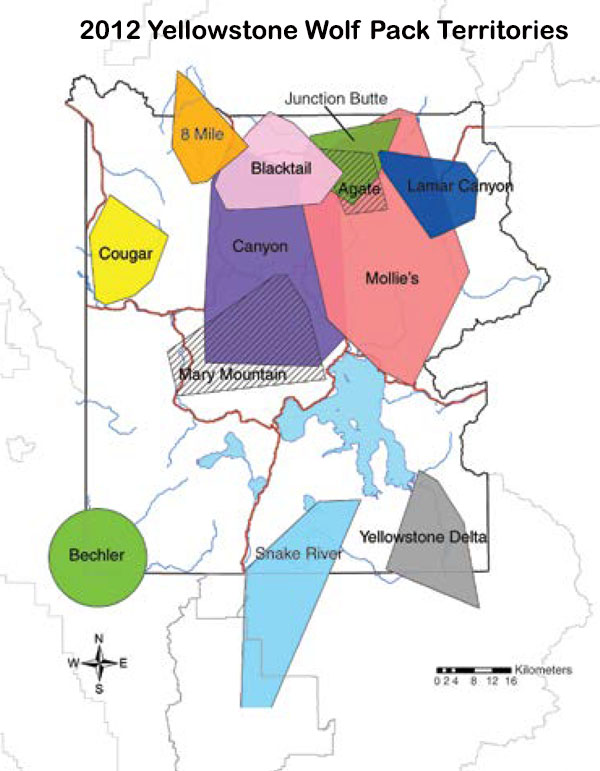
| Yellowstone Wolf Pack Data as of 2012 | |||
|---|---|---|---|
| Pack | Adults | End of Year Pup Count | Total |
| 8 Mile | 7 | 3 | 10 |
| Blacktail | 4 | - | 4 |
| Lamar Canyon (formerly 755 group) | 7 | 4 | 11 |
| Junction Butte | 7 | 2 | 9 |
| Northern Range Totals | 25 | 9 | 34 |
| Non-Northern Range | |||
| Pack | Adults | End of Year Pup Count | Total |
| Bechler | 8 | 2 | 10 |
| Canyon | 6 | 2 | 8 |
| Cougar Creek | 6 | 5 | 11 |
| Mollie's | 5 | - | 5 |
| Yellowstone Delta | 11 | - | 11 |
| Non-Northern Range Totals | 38 | 11 | 49 |
| Totals | 63 | 20 | 83 |
Data as of 04 January 2013 furnished by the NPS
| Wolf Population Estimate by Recovery Area as of 2011 | |
|---|---|
| Area | Wolves |
| Central Idaho Recovery Area | 797 |
| Greater Yellowstone Area | 499 |
| Northwestern Montana | 431 |
| Total (113 Breeding Pairs) | 1727 |
| Wolf Population Estimate by State as of 2011 | |
|---|---|
| Area | Wolves |
| Idaho | 746 |
| Montana | 653 |
| Wyoming | 328 |
| Oregon | 29 |
| Utah | 0 |
| Washington | 18 |
| Total (113 Breeding Pairs) | 1774 |
For more detailed information, please click on the Year Link at the bottom of this page.
2011 Executive Summary
At the end of 2011, at least 98 wolves in 10 packs plus 2 loners occupied Yellowstone National Park. The population size (97 wolves) and number of breeding pairs (8) is the same as at the end of 2010. However, the wolf population on the northern range has declined approximately 60% since 2007, mostly because of a smaller elk population, the main food of northern range wolves. The interior wolf population has declined less, probably because they augment their diet with bison. The severity of mange continued to decline in 2011, although some packs still showed signs of the mite. There was no evidence that distemper was a mortality factor as it was in 1999, 2005 and 2008. Pack size ranged from 3 (Agate Creek) to 19 (Mollie's) and averaged 10.2; the long-term average is 10. All nine packs that we had information on had pups. (We could not assess the reproductive status of the Bechler pack). The average number of pups in early winter for packs that had pups was 4.1, compared to 4.8 in 2010 and 3.8 in 2009. A total of 34 pups in survived to year end in the park, four less than in 2010.
Project staff detected 343 kills (definite, probable, and possible combined) made by wolves in 2011, including 267 elk (78%), 15 bison (4%), 18 deer (5%), 1 moose (less than 1%), 2 pronghorn (less than 1%), 2 bighorn sheep (less than 1%), 2 badgers (less than 1%), 1 jackrabbit (less than 1%), 14 coyotes (4%), 1 raven (less than 1%), 7 wolves (2%), and 13 unknown prey (4%). The composition of elk kills was 27% calves, 3% yearlings, 44% cows, 18% bulls, 3% adults of unknown sex, and 6% of unknown sex and age. Bison kills included 5 calves, 1 yearling, 2 cows, 6 bulls, and 1 adult of unknown sex.
Other research included population genetics, population regulation, disease, hunting behavior, spatial analyses of territory use, wolf pack leadership, multi-carnivore-scavenger interactions, breeding behavior, dispersal, and observations of wolf, grizzly bear, and bison interactions in Pelican Valley.
In 2011, 12 wolves from six packs were captured and collared. At year's end 17% of the park's wolf population was collared. Wolf management activities included den site closures, several hazing events, and one removal of a food-conditioned wolf. Staff continued to manage wolf viewing areas in Slough Creek and Lamar Valley and other places where wolves were frequently sighted.
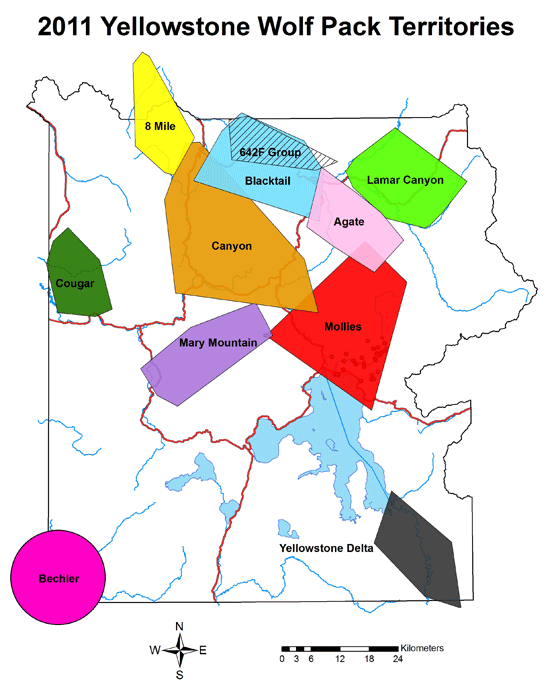
For more detailed information, please click on the Year Link at the bottom of this page.
Yellowstone Wolf Project - 2010 Summary
At the end of 2010, at least 97 wolves (11 packs and 6 loners) occupied Yellowstone National Park (YNP). This is nearly the same size population as in 2009 (96 wolves) and represents a stable population. Breeding pairs increased from six in 2009 to eight in 2010. The wolf population declined 43% from 2007 to 2010, primarily because of a smaller elk population, the main food of northern range wolves. The interior wolf population declined less, probably because they augment their diet with bison. The severity of mange declined in 2010 and there was no evidence of distemper being a mortality factor as it was in 1999, 2005, and 2008. Pack size ranged from 3 (Grayling Creek) to 16 (Mollie's) and averaged 8.3, slightly higher than in 2009 (7.1), but lower than the long-term average of 10 wolves per pack. Eight of the 11 packs reproduced (73%). The average number of pups per pack in early winter for packs that had at least one pup was 4.8, compared to the 2009 average of 3.8. A total of 38 pups in YNP survived to year end.
Wolf Project staff detected 268 wolf kills in 2010 (definite, probable, and possible combined), including 211 elk (79%), 25 bison (9%), 7 deer (3%), 4 wolves (1%), 2 moose (less than 1%), 2 pronghorn (less than 1%), 2 grizzly bears (less than 1%), 4 coyotes (1%), 2 ravens (less than 1%), and 10 unknown species (4%). The composition of elk kills was 43% cows, 25% calves, 18% bulls, and 15% elk of unknown sex and/or age. Bison kills included 4 calves, 6 cows, 7 bulls, and 8 unknown sex adults. Intensive winter and summer studies of wolf predation continued.
Other research included population genetics, disease, hunting behavior, spatial analyses of territory use, wolf pack leadership, multi-carnivore–scavenger interactions, breeding behavior, dispersal, and observations of wolf, grizzly bear, and bison interactions in Pelican Valley.
Eighteen wolves from eight packs were captured and collared during 2010. At year end, 28 of the 97 (about 30%) known wolves in the park were collared.
Wolf management activities included den site closures and four incidents of hazing habituated wolves, each of minor significance (yelling, horn blowing, etc.). Staff continued to manage wolf viewing areas in Slough Creek, Lamar Valley, and other places where wolves were frequently sighted. Wolf Project staff made 16,225 visitor contacts and counted about 38,000 people observing wolves; both figures were record highs for the program. Wolf Project public outreach included 248 talks (30% more) and 83 interviews (10% fewer).
Additional information on wolves in Yellowstone is available at www.nps.gov/yell/naturescience/wolves.htm, www.greateryellowstonescience.org, and www.western-graywolf.fws.gov.
| Yellowstone Wolf Pack Data as of 2010 | |||
|---|---|---|---|
| Pack | Adults | End of Year Pup Count | Total |
| Agate | 4 | 4 | 8 |
| Blacktail | 8 | 6 | 14 |
| Lamar Canyon (formerly 755 group) | 3 | 4 | 7 |
| Quadrant Mountain | 7 | 0 | 7 |
| Lone / Non-Pack Wolves (470F, 692F) | 2 | 0 | 2 |
| Northern Range Totals | 24 | 14 | 38 |
| Non-Northern Range | |||
| Pack | Adults | End of Year Pup Count | Total |
| Bechler (no radio collared wolves) | 4 | 7 | 11 |
| Canyon | 3 | 3 | 6 |
| Cougar Creek | 4 | 0 | 4 |
| Grayling | 3 | 0 | 3 |
| Mary Mountain (formerly 636M Group) | 4 | 2 | 6 |
| Mollie's | 9 | 7 | 16 |
| Yellowstone Delta | 4 | 5 | 9 |
| Lone / Non-Pack Wolves | 4 | 0 | 4 |
| Non-Northern Range Totals | 35 | 24 | 59 |
| Totals | 59 | 38 | 97 |
Data as of 29 July 2010 furnished by the NPS
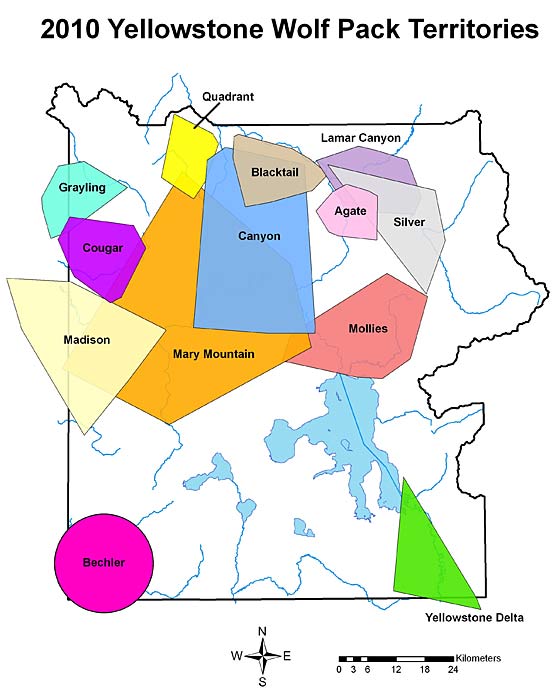
For more detailed information, please click on the Year Link at the bottom of this page.
| Wolf Population Estimate by Recovery Area as of 2009 | |
|---|---|
| Area | Wolves |
| Central Idaho Recovery Area | 913 |
| Greater Yellowstone Area | 455 |
| Northwestern Montana | 319 |
| Total (113 Breeding Pairs) | 1687 |
| Wolf Population Estimate by State as of 2009 | |
|---|---|
| Area | Wolves |
| Idaho | 843 |
| Montana | 524 |
| Wyoming | 320 |
| Total (113 Breeding Pairs) | 1687 |
| Yellowstone National Park Wolf Press Release National Park Service U.S. Department of the Interior Press Release - 16 September 2009 |
|---|
|
Yellowstone National Park YELLOWSTONE NATIONAL PARK NEWS RELEASE ---------------------------------------------------------------------------- New Study Shows Distemper Linked To Yellowstone Wolf Pup Deaths Since wolves were reintroduced in Yellowstone in the 1990s, there have been three years when the pup survival rate was extremely low: 1999, 2005, and 2008. Canine parvovirus was believed to be the cause of the wolf pup deaths in 1999 and 2005. That was because parvovirus is known to cause a high mortality rate in domestic dogs, and was suspected in the high death rate of wolves at Isle Royale National Park in Michigan in the early 1980s. Results of newly published research point to canine distemper as the cause of the low pup survival rates. Researchers took blood samples from wolves and coyotes in Yellowstone National Park. They looked for exposure to a number of canine diseases. The results indicate that some diseases like parvovirus are chronic in the park's wild canines. However, signs of distemper appeared only in the years when pup mortality was high. Since distemper weakens the immune system and makes infected animals susceptible to other infections, it can be difficult to determine the actual cause of death. The research also indicates that the wolf population seems to fare well despite some chronic infections, and rebounds well from periodic exposure to distemper. While the research was unable to conclusively determine the episodic source of the canine distemper, data suggests it is not linked to the region's domestic dog population. The research was conducted by the Yellowstone Wolf Project, the University of Minnesota, and the Yellowstone Ecological Research Center. The findings were recently posted to PLoS ONE, a peer reviewed online journal which posts reports of original research in science and medicine: A Serological Survey of Infectious Disease in Yellowstone National Park's Canid Community. |
2009 Executive Summary
At the end of 2009, at least 96-98 wolves in 14 packs (6 breeding pairs), 1 non-pack grouping, and 2 loners occupied Yellowstone National Park (YNP). This represents a 23% decline from 124 wolves in 2008. Despite the decline the number of breeding pairs did not change (6 in both 2008 & 2009). Intraspecific strife, food stress, and mange were likely cause for the decline. So far, there is no evidence of distemper as a cause of mortality, unlike previous population declines in 1999, 2005 and 2008. Pack size ranged from 3 (Lava Creek & Canyon) to 17 (Gibbon Meadows) and averaged 7.1, down from the long-term average of 9.8 wolves/pack. The average number of pups/pack in early winter was 1.8 for all packs, but 3.8 for packs that had pups, also down compared to the long-term average of 4.0 pups/pack.
Project staff detected 365 wolf kills including 302 elk (83%), 19 bison (5%), 17 deer (2%), 1 moose (less than 1%), 4 pronghorn (less than 1%), 1 bighorn sheep (less than 1%), 1 Canada goose (less than 1%), 1 bald eagle (less than 1%), 3 coyotes (less than 1%), 2 red foxes (less than 1%), 6 wolves (2%), and 8 unknown prey (2%). The composition of elk kills was 24% calves, 36% cows, 29% bulls, and 10% unknown sex and/or age. Bison kills included 7 calves, 4 cows, 3 bulls, and 5 unknown sex adults. Intensive winter and summer studies of wolf predation continued.
Other research included population genetics, disease, hunting behavior, spatial analyses of territory use, wolf pack leadership, multi-carnivore-scavenger interactions, breeding behavior, dispersal, and observations of wolf, grizzly bear and bison interactions in Pelican Valley.
Twenty-two wolves were captured and collared in 11 packs. At year's end, 32 of 96 (35%) wolves were collared.
Wolf management activities included den site closures and hazing of habituated wolves. For the first time a wolf was killed near Old Faithful because it was food conditioned and a human safety threat. The Canyon pack denned within one mile of Mammoth Hot Springs and they were hazed from the developed area causing them to re-locate their den. Staff continued to manage wolf viewing areas in Lamar Valley and other hot spots where wolves were frequently sighted leading to 31,000 people observing wolves and 15,285 visitor contacts by Wolf Project staff. Wolf Project public outreach included 183 talks and 90 interviews to all types of groups and media including scientific conferences. (Information provided by Yellowstone staff)
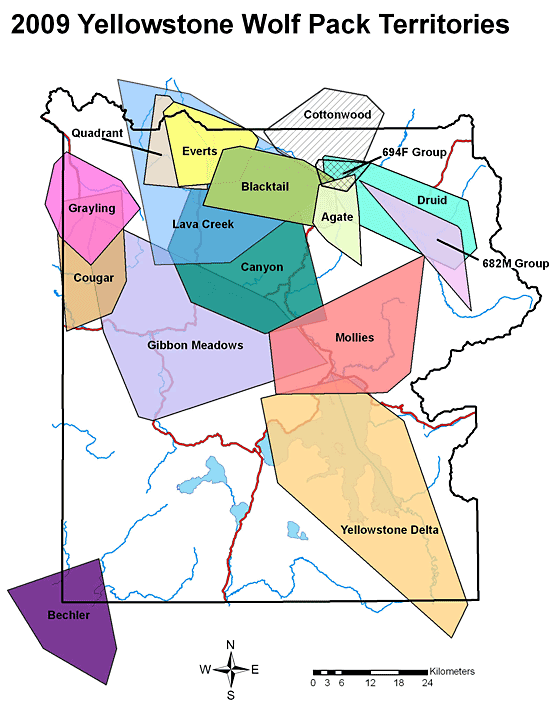
| Yellowstone Wolf Pack Data as of 2009 | |||
|---|---|---|---|
| Northern Range | |||
| Pack | Adults | End of Year Pup Count | Total |
| Agate | 4 | 4 | 8 |
| Blacktail | 10 | 6 | 16 |
| Lamar Canyon (formerly 755 group) | 3 | 4 | 7 |
| Quadrant Mountain | 7 | 0 | 7 |
| Silver | 5 | 4 | 9 |
| Lone / Non-Pack Wolves (470F, 471F, 684M) | 3 | 0 | 3 |
| Northern Range Totals | 32 | 18 | 50 |
| Non-Northern Range | |||
| Pack | Adults | End of Year Pup Count | Total |
| 636M Group | 4 | 0 | 4 |
| Bechler (no radio collared wolves) | 3 | 12 | 15 |
| Canyon | 3 | 3 | 6 |
| Cougar Creek | 4 | 0 | 4 |
| Grayling | 4 | 0 | 4 |
| Madison | 8 | 5 | 13 |
| Mollie's | 11 | 6 | 17 |
| Yellowstone Delta | 4 | 5 | 9 |
| Lone / Non-Pack Wolves (578F +3, 587M +2, 640F) | 8 | 0 | 8 |
| Non-Northern Range Totals | 49 | 31 | 80 |
| Totals | 81 | 49 | 130 |
For more detailed information, please click on the Year Link at the bottom of this page.
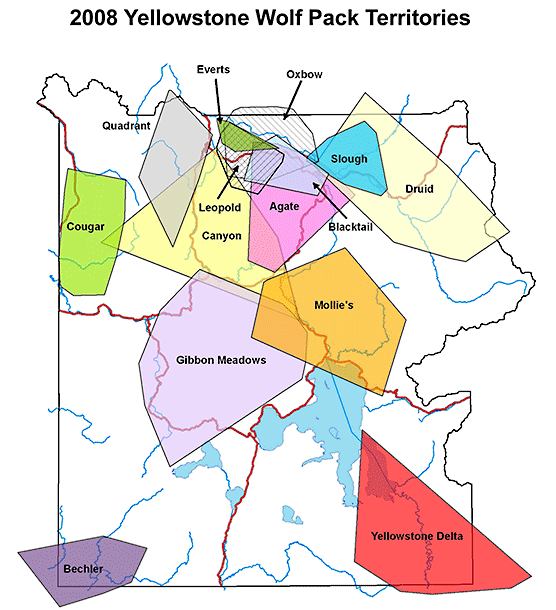
| Yellowstone Wolf Pack Data as of 2008 | |||
|---|---|---|---|
| Pack | Adults | End of Year Pup Count | Total |
| 471F Group | 3 | 0 | 3 |
| 527F Group | 3 | 0 | 3 |
| Agate | 4 | 0 | 4 |
| Blacktail Deer Plateau | 8 | 0 | 8 |
| Druid | 8 | 5 | 13 |
| Everts | 5 | 3 | 8 |
| Slough | 7 | 0 | 7 |
| Quadrant Mountain (469F) | 4 | 0 | 4 |
| Lone / Non-Pack Wolves | 6 | - | 6 |
| Northern Range Totals | 48 | 8 | 56 |
| Non-Northern Range | |||
| Pack | Adults | End of Year Pup Count | Total |
| Bechler | 6 | 3 | 9 |
| Canyon | 4 | 0 | 4 |
| Cougar Creek | 4 | 0 | 4 |
| Gibbon Meadows | 19 | 6 | 25 |
| Mollie's | 10 | 3 | 13 |
| Yellowstone Delta | 7 | 2 | 9 |
| Yellowstone Delta Subgroup | 4 | 0 | 4 |
| Non-Northern Range Totals | 54 | 14 | 68 |
| Totals | 102 | 22 | 124 |
| Yellowstone Wolf Summary for 2008 |
|---|
| At the end of 2008, at least 124 wolves in 12 packs and various groups occupied Yellowstone National Park. This is one more pack than in 2007, but several long-term, stable packs were lost and smaller, newly formed packs replaced them. This represents a 27% decline compared to the 2007 population and was similar to the 30% decline in 2005. Only six of these packs were breeding pairs, the smallest count since 2000 (when wolves first reached the minimum requirement for delisting of 30 breeding pairs in Idaho, Montana, and Wyoming). High mortality of both pups and adults caused the low breeding pair count, despite there being 12 packs. Disease and intraspecific mortality are the two primary factors that caused the wolf population decline. |
For more detailed information, please click on the Year Link at the bottom of this page.
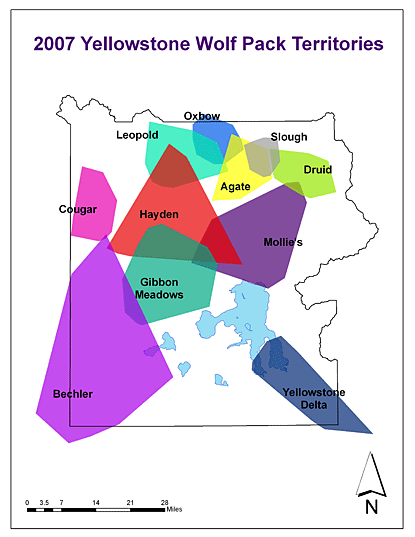
| Yellowstone Wolf Pack Data as of 2007 | |||
|---|---|---|---|
| Pack | Adults | End of Year Pup Count | Total |
| Agate | 8 | 9 | 17 |
| Druid | 9 | 7 | 16 |
| Gardiner's Hole Group | 1 | 1 | 2 |
| Leopold | 13 | 3 | 16 |
| Oxbow Creek | 8 | 8 | 16 |
| Slough | 7 | 9 | 16 |
| 469 F Group | 4 | - | 4 |
| 527 F / B 271 M Idaho Wolf | 2 | - | 2 |
| Lone / Non-Pack Wolves | 5 | - | 5 |
| Northern Range Totals | 57 | 37 | 94 |
| Non-Northern Range | |||
| Pack | Adults | End of Year Pup Count | Total |
| Bechler | 8 | 3 | 11 |
| Cougar Creek | 3 | 4 | 7 |
| Gibbon Meadows | 11 | 6 | 17 |
| Hayden Valley (no collars) | 1 | 3 | 4 |
| Mollie's | 9 | 5 | 14 |
| Yellowstone Delta | 16 | 6 | 22 |
| Lone / Non-Pack Wolves | 2 | - | 2 |
| Non-Northern Range Totals | 50 | 27 | 77 |
| Totals | 107 | 64 | 171 |
For more detailed information, please click on the Year Link at the bottom of this page.
| Annual reports of the Yellowstone Wolf Packs | ||||
|---|---|---|---|---|
| 1995 / 1996 | 2001 | 2006 | 2011 | 2016 |
| 1997 | 2002 | 2007 | 2012 | 2017 |
| 1998 | 2003 | 2008 | 2013 | 2018 |
| 1999 | 2004 | 2009 | 2014 | 2019 |
| 2000 | 2005 | 2010 | 2015 | 2020 |
These are Adobe pdf files
Information provided by Yellowstone National Park
| Let Her Be... She Is Me... By John William Uhler Dedicated to Wolf Number 9 |
|---|
Let her die with the stars and sky in her eyes and the wind in her face - forever wild, free and in her home...
|
| Wolf and Bear Links | |||
|---|---|---|---|
| Wolf Sightings | Bear Sightings | Yellowstone Wolves | US Fish & Wildlife |


| Yellowstone National Park WebCams | |||
|---|---|---|---|
| Old Faithful Live | All Old Faithful | Old Faithful Static | Old Faithful VC |
| Entrance Webcams | Mt Washburn | Mammoth | YVO WebCam |
| North Entrance | Mt Washburn | Mammoth | YVO WebCam |
| Entrance Cities and Gateway Towns | |||
|---|---|---|---|
| Gardiner, Montana | Silver Gate, Montana | West Yellowstone, Montana | Cooke City, Montana |
| Livingston, Montana | Cody, Wyoming | Jackson Hole, Wyoming | Yellowstone National Park |

| Links | |
|---|---|
| The Great Outdoors Net | Great Outdoor Recreational Places |
| Gardiner, Montana | West Yellowstone, Montana |
 |  |